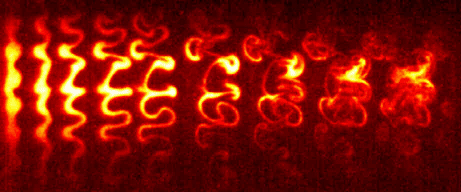Richtmyer-Meshkov Instability
 Richtmyer-Meshkov instability occurs on
impulsively-accelerated (some
people would say, shock-accelerated) density interfaces in fluids or gases.
It is important in practically all processes where things go boom: supernovae,
inertial confinement fusion, nuclear explosions. Besides this importance,
Richtmyer-Meshkov instability has attracted considerable recent attention
because it can serve as a very convenient test problem for transition to
turbulence studies. Experimental measurements of Richtmyer-Meshkov instability
provide benchmarks for validation and verification of numerical codes
modeling turbulent flows.
Richtmyer-Meshkov instability occurs on
impulsively-accelerated (some
people would say, shock-accelerated) density interfaces in fluids or gases.
It is important in practically all processes where things go boom: supernovae,
inertial confinement fusion, nuclear explosions. Besides this importance,
Richtmyer-Meshkov instability has attracted considerable recent attention
because it can serve as a very convenient test problem for transition to
turbulence studies. Experimental measurements of Richtmyer-Meshkov instability
provide benchmarks for validation and verification of numerical codes
modeling turbulent flows.
At The University of New Mexico, Richtmyer-Meshkov instability research is carried out in close collaboration with Sandia and Los Alamos National Laboratories, as well as the University of Texas. A newly developed shock tube at UNM is capable of producing planar shocks with Mach numbers up to 4. The UNM shock tube research is funded by the Defense Threat Reduction Agency (DTRA) and National Nuclear Security Administration (NNSA).
Posters and Videos
- Mushrooms and Snakes (award-winning poster presented at the 1996 APS-DFD meeting).
Online Papers
- Evolution of a shock-accelerated thin fluid layer, Physics of Fluids 9, 1770-1782 (1997).
- Power-Law Spectra of Incipient Gas-Curtain Turbulence, Physical Review Letters 81, 2240-2243 (1998).
- Experimental observations of the mixing transition in a shock-accelerated gas curtain, Physics of Fluids 11, 186-200 (1999).
- Shock-driven gas curtain: Fractal dimension in transition to turbulence, Physica D 133, 469-476 (1999).
- Validation of an instability growth model using particle image velocimetry measurements , Physical Review Letters 84, 4353-4356 (2000).
- Simultaneous density-field visualization and PIV of a shock-accelerated gas curtain, Experiments in Fluids 29, 339-346.
- Flow morphologies of two shock-accelerated unstable gas cylinders, Journal of Visualization 5, 273-283 (2002).
- A quantitative study of the interaction of two Richtmyer-Meshkov-unstable gas cylinders, Physics of Fluids 15, 986-1004 (2003).
- Scaling evolution in shock-induced transition to turbulence, Physical Review E 68, 065301-1 - 065301-4 (2003).
- Two-dimensional simulation of a shock-accelerated gas cylinder, Progress in Computational Fluid Dynamics 7, 427-438 (2007).
- Complex flow morphologies in shock-accelerated gaseous flows, Physica D: Nonlinear Phenomena 235, 21-28 (2007).